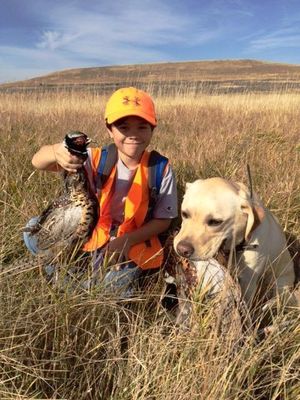Father, son, yellow Lab score pheasants at Fishtrap
HUNTING -- Robert Estuar and his 11 year-old son, Tomas, took a gamble on whether roosters would be stocked at the Fishtrap release site for Saturday's opening of the Eastern Washington pheasant season.
But they found birds and made the best of the day with their yellow Lab, Bella.
- The state wasn't telling which sites would be stocked for the opener. Continue reading for details about the release program at 23 sites in Eastern Washington
Pheasant hunting opened Saturday in Eastern Washington, where the good ol’ days faded away with the advent of bigger machinery and cleaner farming.
In a tradition that started in the late 1990s, pen-raised pheasants are being released at 23 designated East Side sites this season. Despite the non-toxic shot requirement, these sites are popular with hunters who don’t have permission to hunt private land.
The first releases of the year occurred at all sites before the Sept. 21-22 youth upland bird season. The next releases occurred before the Oct. 19 season opener.
However, only about half the sites were stocked with birds for the opener, said Joey McCanna, Washington Department of Fish and Wildlife biologist. The other sites will be stocked the following week, he said. All the sites will be stocked two more times during the season.
But the agency does not divulge which sites will be stocked when.
This bit of chance and inconvenience dates back to the bad experiences agency staff had years ago when hunters often waited at designated sites for the game farm trucks to show up. In some cases, greedy hunters created dangerous situations, sometimes even blasting away as the birds were being released.
Times have changed in other ways since the early years of the Eastern Washington Pheasant Enhancement Program, when the Washington Legislature required 80 percent of the funding to be spent on releasing birds while the rest was earmarked for pheasant habitat efforts.
In 2008, about $270,000 was spent to release birds on the East Side and about $32,000 went to habitat.
That year, with legislative approval, Washington Fish and Wildlife managers approved a phased-in schedule to reduce the number of birds planted until the spending equaled about 50 percent for birds and 50 percent for habitat.
“We’re right about there this year,” McCanna said, noting that 11,350 rooster pheasants will be released at the sites this year. That’s down from 11,820 last year and down from more than 20,000 birds in the initial years.
Hunter groups have supported the department’s emphasis on working with farmers to enhance habitat for wild pheasants. Methods include developing plantings that improve pheasant productivity on lands seeded into the federal Conservation Reserve Program.
For the hunters bummed by news of fewer birds destined for release sites this season, McCanna has some encouragement: “We heard from the senior hunters, who were out the week after the youth hunters, that they were seeing quite a few birds, apparently quite a few wild birds, at the release sites and other places where they found good habitat.”

